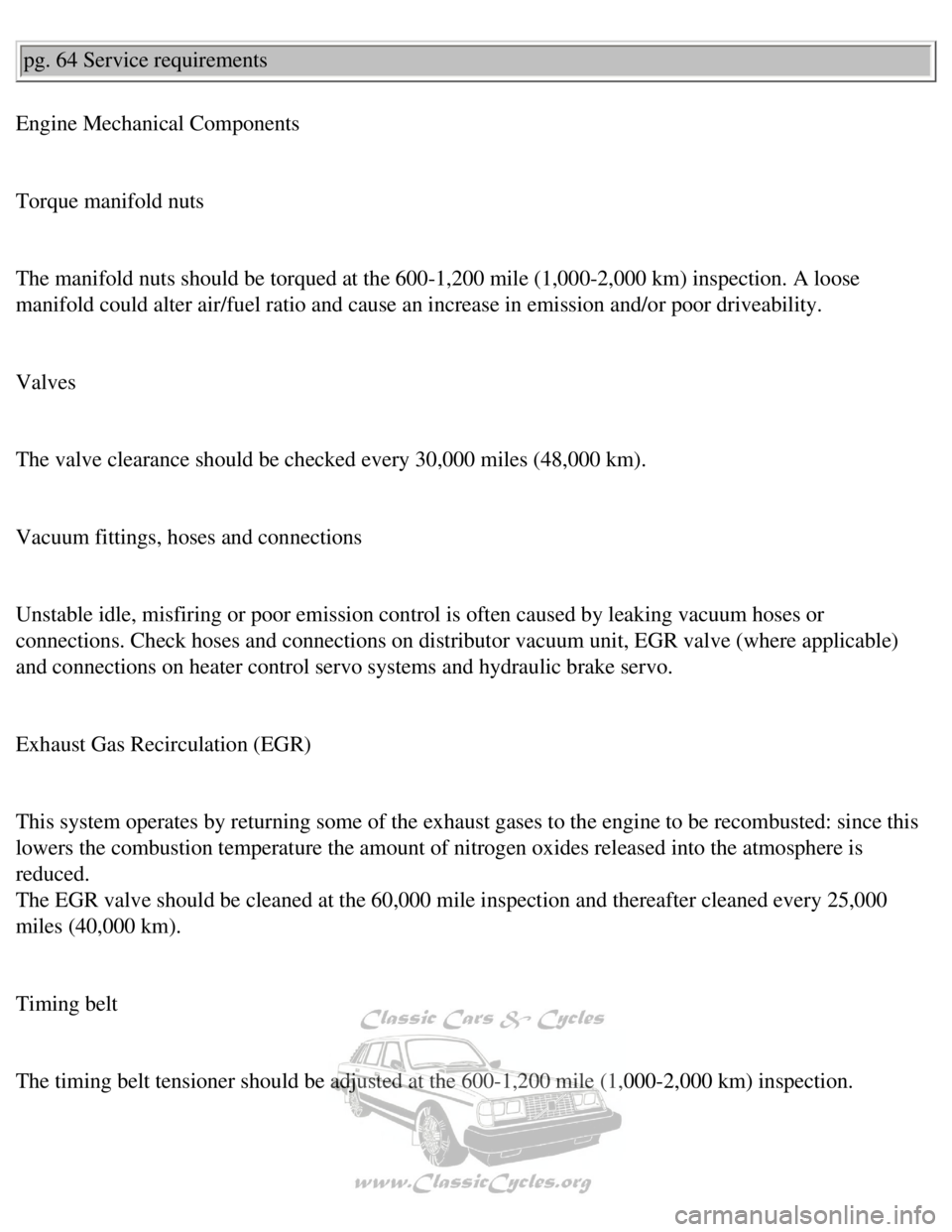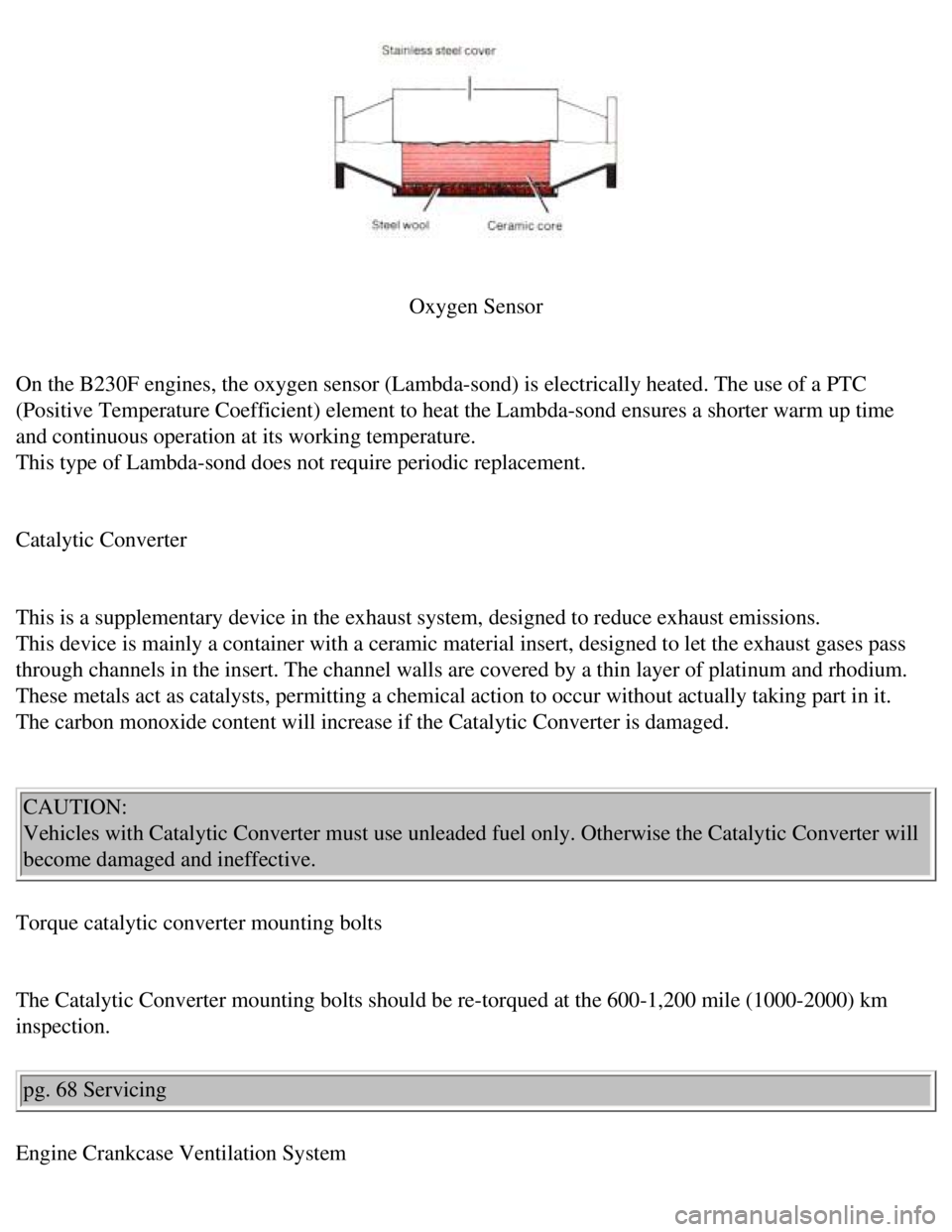Page 73 of 143
Volvo 1990 240 Model
EMISSIONS
SYSTEM
MAINTENANCE
Engine oil and oil
filter R
R R R R R R R R R R R R
Cooling system
hoses and
connections I
Engine drive belts A I I
Torque manifold
nuts A
Valve clearance I I
Timing belt A R (3)
Vacuum fittings,
hoses and
connections I
Air cleaner filter R R
Idle RPM I
Fuel system cap,
tank, lines and
connections I
file:///K|/ownersdocs/1990/1990_240/90240_12.htm (4 of 7)12/30/2006 8:\
25:07 AM
Page 86 of 143

Volvo 1990 240 Model
pg. 64 Service requirements
Engine Mechanical Components
Torque manifold nuts
The manifold nuts should be torqued at the 600-1,200 mile (1,000-2,000 \
km) inspection. A loose
manifold could alter air/fuel ratio and cause an increase in emission an\
d/or poor driveability.
Valves
The valve clearance should be checked every 30,000 miles (48,000 km). \
Vacuum fittings, hoses and connections
Unstable idle, misfiring or poor emission control is often caused by lea\
king vacuum hoses or
connections. Check hoses and connections on distributor vacuum unit, EGR\
valve (where applicable)
and connections on heater control servo systems and hydraulic brake serv\
o.
Exhaust Gas Recirculation (EGR)
This system operates by returning some of the exhaust gases to the engin\
e to be recombusted: since this
lowers the combustion temperature the amount of nitrogen oxides released\
into the atmosphere is
reduced.
The EGR valve should be cleaned at the 60,000 mile inspection and therea\
fter cleaned every 25,000
miles (40,000 km).
Timing belt
The timing belt tensioner should be adjusted at the 600-1,200 mile (1,0\
00-2,000 km) inspection.
file:///K|/ownersdocs/1990/1990_240/90240_14.htm (1 of 7)12/30/2006 8:\
25:08 AM
Page 89 of 143

Volvo 1990 240 Model
Oxygen Sensor
On the B230F engines, the oxygen sensor (Lambda-sond) is electrically \
heated. The use of a PTC
(Positive Temperature Coefficient) element to heat the Lambda-sond ens\
ures a shorter warm up time
and continuous operation at its working temperature.
This type of Lambda-sond does not require periodic replacement.
Catalytic Converter
This is a supplementary device in the exhaust system, designed to reduce\
exhaust emissions.
This device is mainly a container with a ceramic material insert, design\
ed to let the exhaust gases pass
through channels in the insert. The channel walls are covered by a thin \
layer of platinum and rhodium.
These metals act as catalysts, permitting a chemical action to occur wit\
hout actually taking part in it.
The carbon monoxide content will increase if the Catalytic Converter is \
damaged.
CAUTION:
Vehicles with Catalytic Converter must use unleaded fuel only. Otherwise\
the Catalytic Converter will
become damaged and ineffective.
Torque catalytic converter mounting bolts
The Catalytic Converter mounting bolts should be re-torqued at the 600-1\
,200 mile (1000-2000) km
inspection.
pg. 68 Servicing
Engine Crankcase Ventilation System
file:///K|/ownersdocs/1990/1990_240/90240_14.htm (4 of 7)12/30/2006 8:\
25:08 AM
Page 91 of 143

Volvo 1990 240 Model
Evaporative control systems
Vehicles intended for the North American market are equipped with a fuel\
vapor evaporative control
system, which prevents gasoline fumes from being released into the atmos\
phere.
The system is comprised of an expansion chamber in the fuel tank, a roll\
-over valve on the cross
member in front of the fuel tank, and a charcoal canister with built-in \
vacuum valve. The components
are interconnected by hoses which channel fuel vapor from the gas tank t\
o the charcoal filter where they
are stored until the engine is started and then drawn into the engine fu\
el induction system.
Engine Ignition
Change spark plugs
The spark plugs should be changed every 30,000 miles (48,000 km).
However, prolonged city driving or fast highway driving may necessitate \
changing spark plugs after
10,000 miles (16,000 km) of driving. When installing new plugs, be sur\
e to fit the right type and use the
correct torque, see "Specifications".
When changing the spark plugs, check that the suppressor connectors are \
in good condition. Cracked or
damaged connectors should be replaced.
When changing spark plugs, clean the cables and cable terminals, also th\
e rubber seals. If the car is
driven on roads where salt is used during the winter, coat the cables wi\
th silicone.
file:///K|/ownersdocs/1990/1990_240/90240_14.htm (6 of 7)12/30/2006 8:\
25:08 AM
Page 133 of 143
Volvo 1990 240 Model
filter. Exhaust-emission control accomplished by fuel injection, Lambda-\
sond system and catalytic
converter.
Output (SAE J1349) 114 hp at 5400 rpm (85 kW at 90 rps)
Max. torque (SAE J1349) 136 ft. lbs. (185 Nm) at 2700 rpm
Number of cylinders 4
Bore 3.78" (96 mm)
Stroke 3.15" (80 mm)
Displacement 2.32 liters (141 cu. in.)
Compression ratio 9.8:1
Valve clearance, cold engine
inlet and exhaust Checking:
0.012-0.016"
(0.30-0.40 mm) Adjusting:
0.014-0.016"
(0.35-0.40 mm)
Valve clearance, warm
engine
inlet and exhaust 0.014-0.018"
(0.35-0.45 mm)
0.016-0.018"
(0.40-0.45 mm)
All specifications are subject to change without notice. pg. 100 Specifications
Engine B230F
Cooling System
file:///K|/ownersdocs/1990/1990_240/90240_20.htm (4 of 14)12/30/2006 8\
:25:15 AM
Page 134 of 143
Volvo 1990 240 Model
Type Positive pressure, closed system
Thermostat begins to open at 188.6 ° F
Fan belts, designation HC-38 x 918 (two)
Coolant: Volvo Coolant type C (blue-green)
Fuel system
The engine is equipped with an electronic fuel injection system.
Ignition System
Firing order 1-3-4-2
Ignition setting (12 ° B.T.D.C. at 750 rpm)
Spark plugs Bosch WR7DC (or equivalent)
Spark plug gap 0.028-0.032" (0.7-0.8 mm)
Tightening torque 15-22 ft. lbs. (20-30 Nm)
Distributor, direction of rotation Clockwise pg. 101 Specifications
POWER TRANSMISSION
Manual or automatic transmission. Hypoid type final drive.
Manual transmission M47 II
Reduction ratios:
1st gear 4.03:1
2nd gear 2.16:1
3rd gear 1.37:1 Rear axle reduction ratio:
4th gear 1.00:1 3.31:1
5th gear 0.82:1
Reverse 3.68:1
file:///K|/ownersdocs/1990/1990_240/90240_20.htm (5 of 14)12/30/2006 8\
:25:15 AM